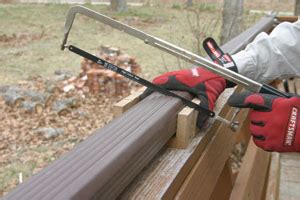Upgrade Your Gutter Game: Hacksaw Cutting Tips
Gutters are crucial for protecting your home's foundation and landscaping from water damage. Sometimes, though, you need to cut your gutters – whether it's for a custom fit, repair, or a DIY installation. While power tools offer speed, a hacksaw provides a precise, controlled cut, especially useful in tight spaces or when working with delicate materials. This guide provides expert hacksaw cutting tips to help you conquer your gutter project.
Why Use a Hacksaw for Gutter Cutting?
While power tools might seem faster, a hacksaw offers several advantages for gutter cutting:
- Precision: Hacksaws allow for finer control, minimizing the risk of damaging the gutter's delicate material. This is especially important when working with aluminum gutters, which can easily dent or bend.
- Accessibility: In tight spaces or areas with limited access, a hacksaw is often the only practical tool. Its maneuverability makes it ideal for intricate cuts.
- Control: You have complete control over the speed and direction of the cut, minimizing the chance of accidental slips or uneven cuts.
- Cost-Effectiveness: A hacksaw is a relatively inexpensive tool, making it a viable option for occasional gutter work.
Choosing the Right Hacksaw and Blade
Selecting the appropriate hacksaw and blade is critical for a clean, efficient cut. Consider these factors:
- Blade Type: A fine-tooth blade (18-24 teeth per inch) is best for aluminum and vinyl gutters. The finer teeth provide smoother cuts and reduce the chance of tearing the material. For heavier-gauge metal gutters, a coarser blade (14-18 teeth per inch) might be necessary.
- Hacksaw Type: A standard hacksaw with a comfortable grip is sufficient for most gutter cutting tasks. An adjustable hacksaw is advantageous for various cutting angles.
- Blade Length: Choose a blade long enough to provide ample cutting depth without being overly cumbersome.
Hacksaw Cutting Techniques for Gutters
Mastering the technique ensures a clean, straight cut:
- Marking the Cut Line: Use a sharpie or pencil to mark the precise cutting location on the gutter. A straight edge (like a level or ruler) will ensure accuracy.
- Secure the Gutter: Firmly clamp or otherwise secure the gutter to a stable work surface. This prevents movement during the cutting process, leading to a straight, accurate cut.
- Starting the Cut: Begin the cut slowly and steadily, using gentle pressure. Avoid applying too much force, which can cause the blade to bind or break.
- Maintaining Straightness: Keep the hacksaw blade perpendicular to the gutter throughout the cutting process. A slight rocking motion can help keep the blade from binding.
- Consistent Pressure: Maintain consistent pressure on the hacksaw while cutting to ensure an even pace and prevent bending the gutter.
- Finishing the Cut: As you approach the end of the cut, reduce the pressure to prevent the gutter from tearing or cracking.
Troubleshooting Common Hacksaw Cutting Issues
- Blade Binding: If the blade binds, check if the gutter is properly secured. Applying a lubricant (like WD-40) to the blade can also help.
- Uneven Cuts: This is often due to inconsistent pressure or improper blade alignment. Practice on scrap material before cutting your gutters.
- Damaged Gutter: Excessive force can cause damage. Always use a sharp blade and apply gentle, even pressure.
Hacksaw Cutting Safety Precautions
- Eye Protection: Always wear safety glasses or goggles to protect your eyes from flying debris.
- Gloves: Consider wearing work gloves for a better grip and to protect your hands.
- Sharp Blade: Replace dull blades immediately to prevent accidents and ensure a clean cut.
- Proper Workspace: Work in a well-ventilated area and ensure the work surface is stable and secure.
What type of hacksaw blade is best for cutting aluminum gutters?
A fine-tooth blade (18-24 teeth per inch) is ideal for aluminum gutters. The finer teeth provide a smooth cut and minimize the risk of damaging the soft aluminum.
Can I use a hacksaw to cut vinyl gutters?
Yes, a fine-tooth hacksaw can also be used for cutting vinyl gutters, but you’ll need to take extra care to avoid cracking or chipping the material. Go slowly and apply even pressure throughout the cut.
What are some alternatives to a hacksaw for cutting gutters?
While a hacksaw offers precision and control, other options include a jigsaw (with the correct blade), tin snips (for thinner gutters), or an angle grinder (for thicker metal gutters). However, these require more experience and skill to prevent damage.
By following these tips and precautions, you can confidently use a hacksaw to make precise cuts on your gutters, ensuring a successful and safe DIY project. Remember, practice makes perfect, so don't hesitate to try on scrap material before tackling your main gutter project.

